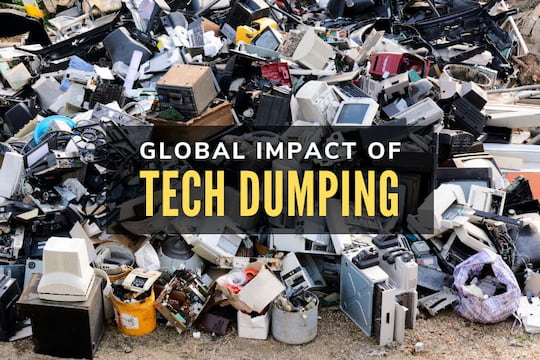In today’s digitally driven world, the surge in technological innovation has brought about incredible advancements for businesses and governments alike. However, it has also led to a concerning byproduct: the environmental impact of e-waste. As a company dedicated to responsible recycling, we understand the crucial need for addressing this pressing issue. Without decisive action, the consequences of unchecked e-waste could escalate to irreparable environmental damage and public health crises.
Understanding the Scale of e-Waste
The term e-waste encompasses discarded electrical and electronic devices ranging from old computers and printers to mobile phones and refrigerators. To put this in perspective, the world generated a staggering 53.6 million metric tons of e-waste in 2019 alone, and this figure is projected to exceed 74 million metric tons by 2030. The implications of this growing wave of e-waste reach beyond cluttered landfills; they pose significant threats to our environment and well-being. You can explore a comprehensive e waste definition to gain more insight into the various items classified as e-waste.
Toxic Components: A Hidden Threat

One of the most alarming aspects of the environmental impact of e-waste is the toxic components found in these discarded electronics. Items like computer monitors, batteries, and circuit boards often contain hazardous substances such as lead, mercury, cadmium, and brominated flame retardants. When improperly disposed of, these materials can leach into the soil and groundwater, contaminating ecosystems and posing severe health risks to nearby communities.
Impact on Land, Water, and Air
Improper e-waste disposal methods, such as landfilling and incineration, contribute to soil degradation, water contamination, and air pollution. In landfills, toxic substances from e-waste seep into the ground, poisoning the soil and making it unfit for agriculture. Meanwhile, harmful chemicals can infiltrate groundwater, leading to widespread contamination of water sources. And when e-waste is incinerated, it releases dangerous pollutants, including dioxins and furans, which contribute to air pollution and respiratory problems.
The Human Toll of e-Waste Mismanagement
The environmental impact of e-waste goes beyond the ecosystem; it also poses significant health risks to the people who are directly or indirectly exposed to it. Workers at informal recycling centers, especially in developing countries, are often left unprotected from these hazardous materials. Exposure to heavy metals and toxic chemicals can lead to neurological damage, respiratory issues, and a range of other long-term health conditions. Furthermore, communities living near e-waste dumpsites face increased risks of chronic illnesses and developmental disorders.
The Global e-Waste Trade and Ethical Concerns

One troubling trend in e-waste management is the global trade of electronic waste from developed to developing nations. This practice often results in e-waste being dumped in regions where regulations are lax, and where local communities are forced to handle hazardous waste with inadequate safety measures. The environmental impact of e-waste in these regions is exacerbated by poor recycling infrastructure and a lack of enforcement of international regulations.
Recycling Challenges and the Importance of Responsible Disposal
Recycling e-waste is not as straightforward as recycling other materials like glass or paper. The complex and hazardous nature of e-waste components requires specialized processing and technology. However, many regions lack the necessary infrastructure to manage e-waste recycling efficiently. As a result, e-waste often ends up in landfills or is handled informally, amplifying the risks to both the environment and public health.
Governments and businesses must recognize the urgency of adopting sustainable e-waste disposal practices. Certified recycling facilities play a vital role in mitigating the environmental impact of e-waste by ensuring that hazardous components are safely extracted and repurposed. By partnering with reliable recyclers, small businesses and government entities can contribute significantly to reducing the harmful effects of e-waste.
Regulatory Efforts: Progress and Limitations

Over the years, various regulatory frameworks and global initiatives have emerged to address the growing concern of e-waste. For instance, the Basel Convention and the European Union’s Waste Electrical and Electronic Equipment (WEEE) Directive have been instrumental in curbing the international movement of hazardous waste and promoting responsible recycling practices. Additionally, state-level regulations, such as California’s e-waste recycling program, have set an example by establishing strict guidelines for e-waste disposal.
However, despite these efforts, gaps remain in enforcement and public awareness. Governments and businesses must work together to strengthen regulations and raise awareness of the environmental impact of e-waste, encouraging more organizations to embrace sustainable practices.
The Role of Consumers and Manufacturers in Reducing e-Waste
Addressing the environmental impact of e-waste requires a collective effort from manufacturers, consumers, and regulatory bodies. Manufacturers play a critical role in reducing e-waste through sustainable product designs, such as modular devices that are easier to repair and upgrade. The concept of the "right to repair" is gaining traction, pushing companies to provide consumers with the tools and information needed to fix their devices instead of discarding them prematurely.
For consumers, responsible e-waste disposal starts with making informed choices. Opting for refurbished or pre-owned electronics, extending the lifespan of devices through repairs, and utilizing certified recycling programs are effective ways to reduce e-waste at the individual level. Small and medium-sized businesses can lead by example by implementing green IT policies and partnering with certified recyclers.
Innovating for a Greener Future

Innovation is key to addressing the environmental impact of e-waste effectively. As technology advances, so do our options for sustainable waste management. Urban mining, a process that involves extracting valuable metals from e-waste, has the potential to reduce the demand for virgin raw materials while minimizing environmental degradation. Similarly, advancements in recycling technologies are making it easier to recover and repurpose components from discarded electronics.
The transition to a circular economy, where electronic devices are reused, refurbished, and recycled, presents a promising solution to the e-waste crisis. By embracing circularity, businesses and governments can help minimize waste and make the most of our existing resources.
Conclusion: A Call to Action
The environmental impact of e-waste is a growing crisis that demands immediate attention from businesses, governments, and individuals. The toxic components in electronic waste, combined with improper disposal practices, pose significant risks to our environment and health. However, by adopting sustainable practices, supporting responsible recyclers, and embracing innovative solutions, we can turn the tide on this pressing issue.
As we move forward, it’s crucial for businesses, particularly small and medium-sized enterprises, and government entities to prioritize sustainable e-waste disposal and recycling initiatives. By doing so, we not only protect our environment but also set an example for others to follow.
Together, we can create a future where the environmental impact of e-waste is no longer a threat, but a challenge that we’ve collectively overcome. Let’s take this opportunity to lead the way towards a greener, more sustainable future.




















